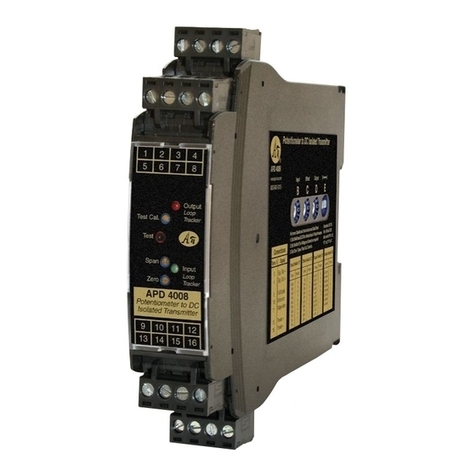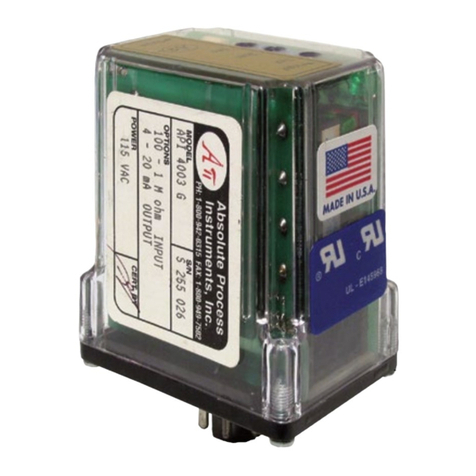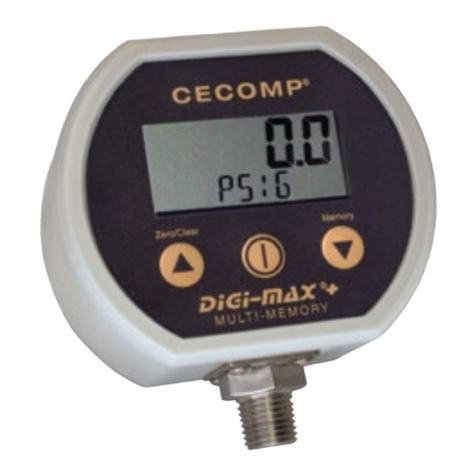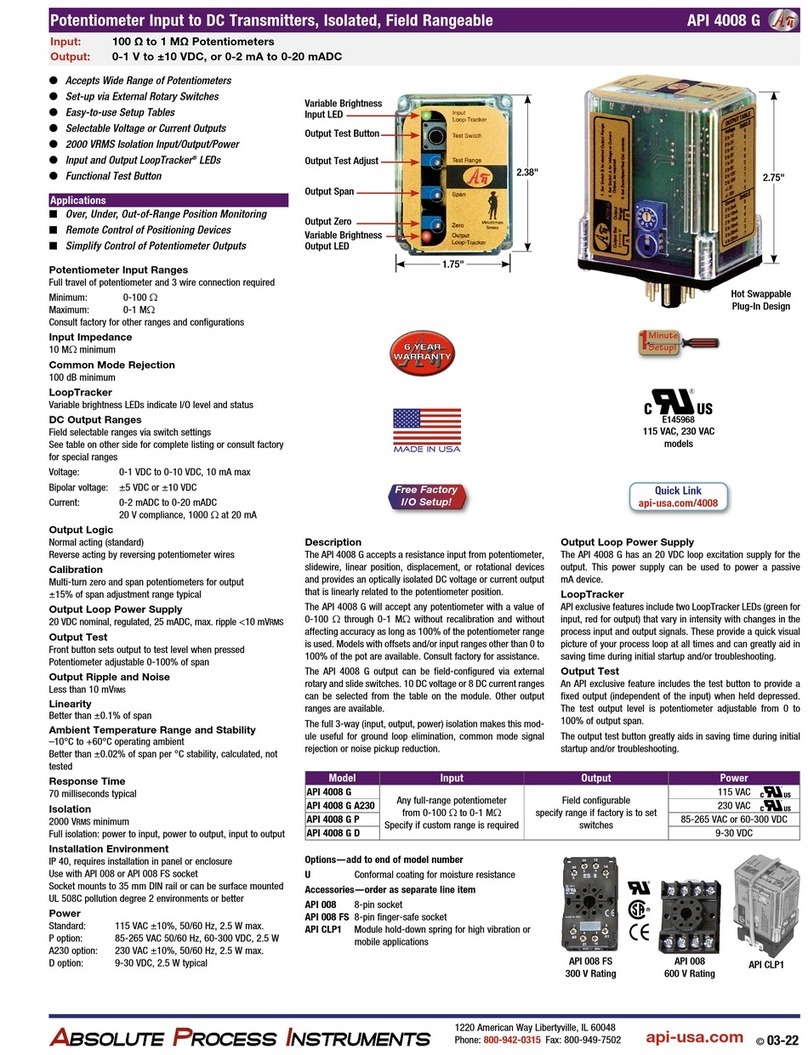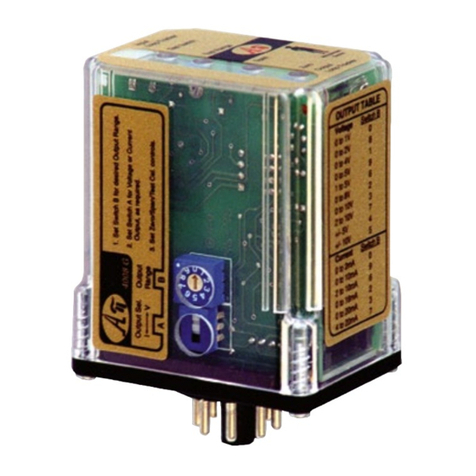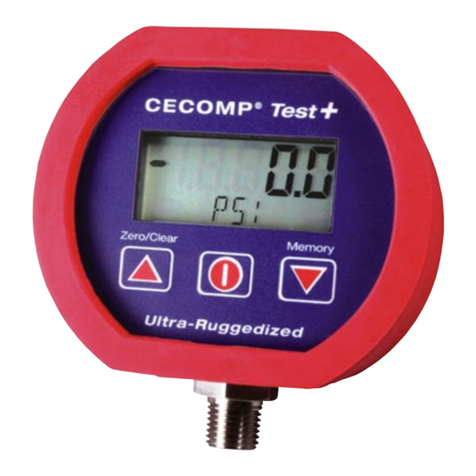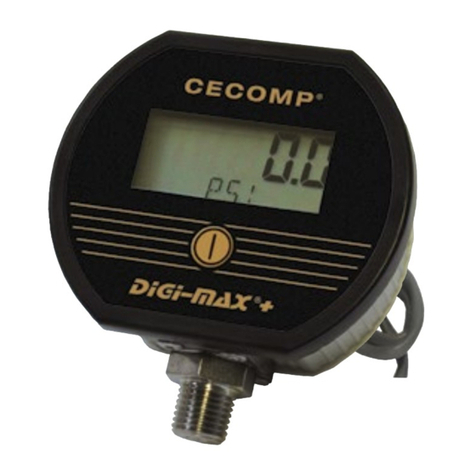
Instructions DPG2000B D4 and M0, M1 Series
¼" NPT
2.88"
3.38"
0.75"
1.65"
Types of Gauges
Gauge reference reads zero with the gauge port open.
Bipolar ranges read positive pressure and vacuum in the same
units, and zero with the gauge port open.
Compound ranges read positive pressure in psig and vacuum
in inHg, and zero with the gauge port open.
Sealed reference reads zero with the gauge port open and is
referenced to 14.7 psi. Used for 1000 psi and up.
Absolute reference reads atmospheric pressure with gauge
port open and zero at full vacuum. With the gauge port open
to atmosphere, it is normal for readings to fluctuate due to
continuously changing barometric pressure.
Dimensions
Operation
Power-Up
Press and hold the front button for approximately 1 second.
The display is tested, the full-scale range is indicated, the
display segments are briefly shown again, then the actual
pressure and units are displayed.
Power Up with Zero
This applies to gauge reference models only. Absolute refer-
ence gauges do not use the zero feature since they read
atmospheric pressure under normal conditions.
Be sure the gauge port is exposed to normal atmospheric pres-
sure and no pressure is applied. The zeroing function is only
activated at each power-up and the stored zero correction is
erased when the gauge is shut off.
Press and hold the front button.
The display is tested.
Continue to press the button until oooo is displayed.
Release the button. The gauge in now zeroed.
The full-scale range is indicated and the display segments are
briefly shown again.
The actual pressure and units are displayed.
Attempting to zero the gauge with pressure greater than
approximately 3% of full-scale pressure or vacuum applied
will result in an error condition, and the display will alternately
indicate Err 0 and the actual measured pressure. The gauge
must be powered down to reset the error condition.
Normal Operation
Following the start-up initialization, the display indicates the
pressure reading updated approximately 3 times per second.
The auto shutoff timer starts when the gauge is powered up or
whenever the button is pushed, unless the gauge shutoff time
was set to zero for on/off operation.
If excessive vacuum is applied to a pressure-only gauge, the
display will indicate -Err until the vacuum is released.
Applying vacuum to a gauge designed for pressure may
damage the pressure sensor. If excessive pressure is applied
(112.5% over range), an out-of-range indication of I – – – or
I.–.–.– will be displayed depending on model.
Shut-Down
To shut off the gauge manually at any time, press and hold
the button until the display indicates OFF (about 5 seconds)
and then release.
When an auto shutoff timer is used, the display indicates OFF
five seconds prior to auto shutoff. Pressed the button to keep
the gauge on. The auto shutoff and backlight (if equipped)
timers are reset whenever the button is pressed and released.
Operation—continued
If the gauge is set up without auto shutoff (on/off operation)
it will stay on until manually shut off or until the batteries are
depleted. Turn gauge off when not in use to conserve battery
life.
Display Backlighting (BL Option Only)
Display backlighting will operate when a button is pressed or
held provided the front light sensor detects low ambient light
levels. Display backlighting will turn on for one minute and
then shut off. Backlighting may not be apparent under some
lighting conditions.
Minimum and Maximum Readings
Minimum and maximum readings are stored continuously
whenever the gauge is on. The stored readings can be manu-
ally cleared if desired. The MIN and MAX memory can be con-
figured to save or clear the reading whenever the gauge is off.
Press and hold the button for about 1 second until MAX is
displayed alternating with the units. The maximum reading will
be continuously updated. The gauge may be left in this mode.
After MAX is displayed, press and hold the button for about 1
second until MIN is displayed alternating with the units. The
minimum reading will be continuously updated. The gauge
may be left in this mode. If excessive vacuum is applied to a
pressure-only gauge while in this mode, the display will indi-
cate -Err until the MAX/MIN readings are cleared.
After MIN is displayed, press and hold the button again for
about 1 second until * * * * is displayed. The MAX and MIN
memory is not erased and the gauge returns to normal opera-
tion with the display indicating the current reading.
Press and continue to hold the button until the display indicates
clr MX/MN (about 3 seconds total) and then release the but-
ton. Both maximum and minimum values are cleared and the
gauge returns to the normal operating mode.
M0 Models are configured with minimum and maximum func-
tions disabled. One or both can be enabled or disabled in the
User Configuration mode.
M1 Models are peak reading gauges that only display and
captures maximum readings. Press and hold the button for
about 1 second until MAX is displayed alternating with the
units. The maximum reading will be continuously updated. The
MAX memory can be configured to save or clear the reading
whenever the gauge is off.
Operation—continued
Battery ReplacementPrecautions
A low battery indication (either LOBAT or a symbol depend-
ing on the model) will be shown in the upper left-hand corner
of the display when the battery voltage falls sufficiently. The
batteries should be replaced when the indicator comes on or
unreliable readings may result.
WARNING: Replace batteries with approved type in non-
hazardous locations only. Replace batteries with two Panasonic
LR03 1.5 V AAA alkaline cells.
Replace both batteries with new ones at the same time. Do
not mix different types of batteries. Substitution of components
may impair intrinsic safety.
1. Remove the 6 Phillips
screws on the back of
the unit.
2. Remove batteries by lift-
ing up the positive end of
the battery (opposite the
spring) taking care not to
bend the spring.
3. Discard old batteries
properly, do not discard
into fire, sources of
extreme heat, or in any
hazardous manner.
4. Install batteries with correct orientation. The negative (flat)
end of each battery should be inserted first facing the bat-
tery holder spring.
5. Replace the back cover, including the rubber gasket.
Approved Locations
The DPG2000B series is approved for use in the following
Hazardous Locations.
IS Class I Div 1 Gp ABCD
T3C Ta = –40ºC to 82ºC; T4 Ta = –40ºC to 66ºC.
CL I Zone 0 AEx/Ex ia IIC
T3 Ta = –40ºC to 82ºC; T4 Ta = –40ºC to 66ºC
Installation
4Read these instructions before installing the gauge.
Configuration may be easier before the gauge is installed.
Contact the factory for assistance.
4Installation instructions must be strictly followed in compli-
ance with Intrinsic Safety National Standard NEC 504 or
ANSI/ISA RP 12.6 and the National Electrical Code.
4Outdoor or wash down applications require a NEMA 4X
gauge or installation in a NEMA 4X housing.
4Use fittings appropriate for the pressure range of the gauge.
4Due to the hardness of stainless steel, it is recommended
that a thread sealant be used to ensure leak-free operation.
4For contaminated media use an appropriate screen or filter
to keep debris out of gauge port.
4Avoid permanent sensor damage! NEVER insert objects into
gauge port or blow out with compressed air.
4Remove system pressures before removing or installing
gauge.
4Install or remove gauge using a wrench on the hex fitting
only. Do not attempt to turn by forcing the housing.
Operation
4Use within the pressure range indicated on gauge label.
4Avoid permanent sensor damage! Do not apply vacuum to
gauges not designated for vacuum operation.
4Use only with media compatible with 316L stainless steel.
Gauges are not for oxygen service. Accidental rupture of
sensor diaphragm may cause silicone oil inside sensor to
react with oxygen.
4The DPG2000B series gauges must only be operated in
specified ambient temperature ranges.
Maintenance
4The non-metallic cover of the pressure gauge is considered
to constitute an electrostatic discharge hazard. Clean only
with a damp cloth.
4Batteries must be replaced when the low battery indication
comes on to prevent unreliable readings.
4WARNING: Replace batteries with approved type in non-
hazardous locations only.
4Approved batteries are two Panasonic LR03 1.5 V AAA
alkaline cells. Replace both batteries at the same time.
p WARNING: Substitution of batteries may impair intrinsic
safety. Improper voltages will damage the gauge.
4WARNING: Substitution of components may impair intrinsic
safety. Do not modify the gauge.
4These products do not contain user-serviceable parts
except for batteries. Contact factory for repairs, service, or
refurbishment.
DS-DPG2000B rev. 12-12
Two
AAA
batteries
cecomp.com
1220 American Way Libertyville, IL 60048
800-942-0315
CECOMPDiv. of
ABSOLUTE PROCESS INSTRUMENTS
Cecomp maintains a constant effort to upgrade and improve its products.
Specifications are subject to change without notice. See cecomp.com for
latest product information. Consult factory for your specific requirements.
WARNING: This product can expose you to chemicals including
lead, nickel and chromium, which are known to the State of
California to cause cancer or birth defects or other reproductive
harm. For more information go to www.P65Warnings.ca.gov
